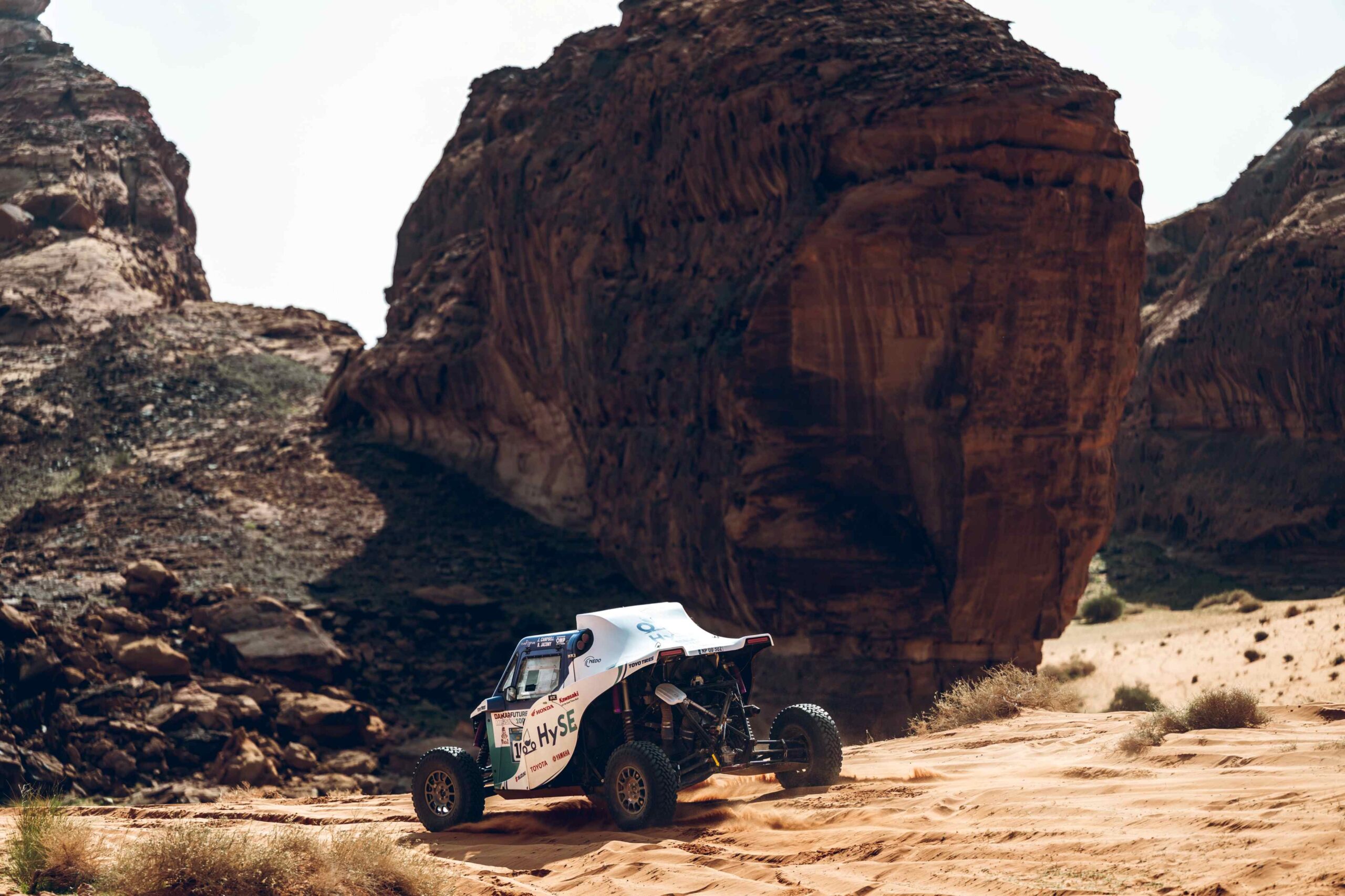Media Information
Hydrogen Small mobility & Engine technology (HySE)
46th Dakar Rally
January 5th-19th, 2024
HYDROGEN-POWERED HYSE-X1 CONTINUES TO MAKE PROGRESS AS DAKAR RALLY REACHES AL-SALAMIYA
AL-SALAMIYA (SAUDI ARABIA) – Monday, January 8: The revolutionary hydrogen-powered HySE-X1 continued its impressive start to an ambitious Dakar Rally campaign with another solid performance on the third stage of the 46th Dakar Rally in deepest Saudi Arabia on Monday afternoon.
The HySE (Hydrogen Small mobility & Engine technology) has been entered in the new modern Dakar class (Mission 1000). This is an integral part of the Dakar Future Programme to encourage manufacturers to develop next-generation carbon-neutral powertrain technologies.
American driver Jamie Campbell and his co-driver Bruno Jacomy, from Argentina, took on their most ambitious challenge thus far on the event with a 108km stage from Al-Duwadimi to Al-Salamiya. The day’s route headed southeast into the eastern section of the vast Riyadh Province. They reached the finish without technical or navigational issues and remain firmly on target to achieve the new project’s objectives.
Quotes after Stage 3 on Monday, January 8th
Jamie Campbell, Driver:
“Stage three wasn’t as hard in terms of navigation and we had some fun moments. Everybody is lost except for us so they were all following us. It makes it a little bit challenging, just because their alarm is going off in our ears! All in all, it was a good day. I think we finished at the minimum of the hydrogen. I’m glad we made it. We had no problems and no navigation issues. I’m improving on reading all the instruments. We had fun.”
Bruno Jacomy, Co-driver:
“Today was 108 (km) and we made it, another positive day for the team and for us. We managed the hydrogen all the stage. We are happy. Tomorrow’s plan is to do the same. Maybe we can attack a little bit more. We have less kilometres and it is not a sand stage. Maybe we push a little bit but not too much so we can reach the end.”
Keita Nakanishi, Project Leader of HySE Dakar Project:
“Continuing from yesterday, stage three was over 100km long. It was slightly longer than stage two and I was worried about whether we would be able to complete it. But the HySE-X1 did the distance safely, almost running out of fuel. After the stage, I asked Bruno about the condition of the track and he said that the first half was wadi and the road surface was very soft sand.
“So, I guess, that condition made the car consume a lot of hydrogen. It was a good experience, as we prepare for stage six later this week. I thank Jamie and Bruno for running the long stages two days in a row. Tomorrow’s stage will have a shorter distance, so I would like to aim to collect data by driving at high speed again.”
The crew tackled a 105km special stage on a desert track between Al-Henakiya and Al-Duwadimi in central Saudi Arabia on Sunday morning. They finished the day’s test without issues and collected the 10 points available to successful crews taking part in the modern Dakar class.
Quotes after Stage 2 on Sunday, January 7th
Jamie Campbell, Driver:
“We wanted to finish the whole stage so we conserved hydrogen all stage, maybe driving at 35-40km/h. Again, Bruno’s navigating was spot on and it was a case of me trying to learn to drive off his navigation. Everything went great with the car.”
Bruno Jacomy, Co-driver:
“It was a good day for us. We had some navigation so we needed to do it ‘on-point’ to make sure we didn’t do more distance. We were running out of fuel so we needed to be aware and clever. It was a good day for the team. We made 105km so it was really good. We are really happy.”
Keita Nakanishi, Project Leader of HySE Dakar Project:
“Stage two had a set distance of 105km. Because of the longest driving record of HySE-X1 so far was up to 70km, there were many uncertainties as to whether we would be able to complete the stage and the distance safely. After the detail was announced by the organisers, we decided to try to complete the 105km distance.
“To make it happen, all team members analysed the course, made a driving plan and then the driver and co-driver executed it well. I thank the whole team for their hard work. The next stage is also over 100km, so we will analyse the data obtained and will try to find a way to speed up a little while increasing the stage distance. We will make a solid plan from now on.”
The HySE-X1 SSV is a joint project between the Japanese automotive manufacturers – Honda, Kawasaki, Suzuki, Toyota and Yamaha – and utilises a chassis built by Overdrive Racing.
The chassis has been modified to accommodate three hydrogen fuel tanks and fuel supply system powering a 998cc, four-stroke supercharged motorcycle engine being used in research and development.
Tomorrow (Tuesday), competitors in the Dakar Future Mission 1000 class tackle another challenging stage of 76km between Al-Salamiya and Al-Hofuf to the northeast. Competitors will then spend the night in a purpose-built bivouac at the historic desert city close to the Al-Ahsa Oasis in Saudi Arabia’s vast Eastern Province surrounded by hectares of date palms.
Ends


